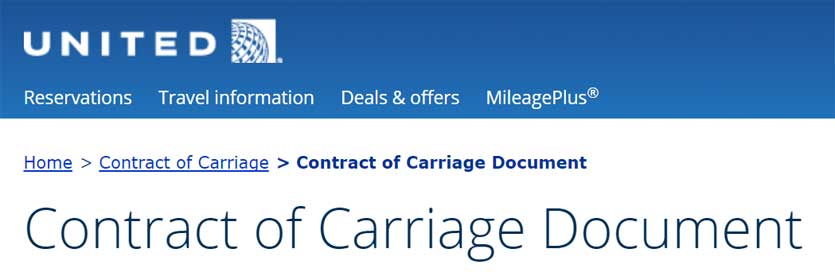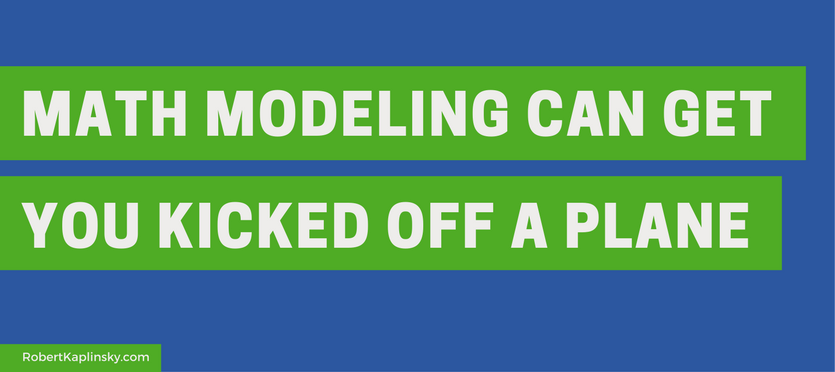[This is one of a series of posts that explore real world examples of mathematical modeling to help educators better understand its applications. This is not intended to be a context for a student lesson. To learn about Spies and Analysts, I recommend watching this webinar (with elementary, middle, and high school versions) or reading this blog post.]
Update: May 8, 2019
Since writing this blog post, I’ve had many people reach out to me to explain how this blog post was a missed opportunity to discuss how bias becomes integrated into mathematical modeling. It had statements that I’ve since changed my thinking on. So, I’ve decided to update the blog post to address these concerns. Thanks to everyone who has patiently helped me broaden my perspective.
Do you remember reading about when Dr. David Dao Duy Anh, a Vietnamese-American passenger, was literally dragged off a United Airlines flight in April 2017? One of the questions people had was “Why was he the one they picked?” He was picked because United Airlines used mathematical modeling to determine that he was their least profitable customer. What I’d like to explore in this blog post is both how they picked him and some of the consequences of doing it this way.
First, some background as to how this happened…
Sometimes airlines have more people that want to fly on a plane than there are seats. This can happen when an airline sells more tickets than there are available seats on the plane. It also happens when an airline needs to send its employees to a city to fly a plane there. While this seems like an awful way to do business, usually, no one notices this way in which airlines try to maximize their profits. This is because there are often empty seats from people who miss their flight. When there aren’t enough seats, then problems happen.
In this specific case, United Airlines wanted to make space for four of their employees. They began by offering the passengers who were already on the plane $400 in vouchers, hotel stay, and a seat on a plane the next day. No one accepted. United then increased the offer to $800 but still no one accepted. At this point, they announced that they would be using a computer to select the four people.
It’s worth acknowledging that there a multitude of bad things that happened to get to this point. United could have kept increasing their offer until someone accepted. They could have had their employees fly on a later plane or another airline’s plane. They could have even seemed more sympathetic to their customers, as many passengers explained that they sounded very rude and unaccommodating. These alternatives could have prevented this from happening at all.
Unfortunately, that didn’t happen and they used a computer’s formula to figure out which customers to kick off the plane. Dr. Dao was selected along with three other passengers. The three other passengers left the plane, but he didn’t. He politely explained that he was a doctor and had patients he needed to see the next day at his clinic. Can you imagine what this might have felt like from his perspective? He paid for a ticket, got on the plane, was waiting to take off, and then told he must leave. Who wouldn’t be frustrated and resistant?
What took place next was extremely disturbing. When he wouldn’t leave, “Chicago Department of Aviation Security Officers were called to remove him from the plane; in the process, they struck Dao’s face against an armrest, then pulled him, apparently unconscious, by his arms along the aircraft aisle past rows of onlooking passengers.” How could this happen? Why was he not afforded dignity and respect? Would this have happened if he was not a person of color?
How we treat people is a big deal. Sometimes we think that a computer’s formula is immune from biases, but is that really true? How do you even write a formula like this? How do you make it fair? What does fair even mean? What are the potential consequences of a formula?
Stop and take thirty seconds to think about this. If you were tasked with writing this formula, out of all the available information, what would you want to help you make this decision? This is where the spy component comes in. What I mean is that with mathematical modeling, one very important but often underappreciated part is acquiring the data. What data do you need? How are you going to get it? When you’ve got an idea of what data you would use, read on.
- how far away a person’s ultimate destination is (potentially kicking off people with shorter trips)
- the distance someone lives from an airport (potentially kicking off people who live closer and have shorter commutes back home)
- how much someone paid for their ticket (potentially kicking off people who paid less)
At a glance, it might seem reasonable to use these factors when making a decision, but let’s consider potential consequences. For example, it makes sense that people who live close to an airport might be less inconvenienced if they have to return home to fly the next day. However, often times the neighborhoods near airports tend to be poorer than average. So, this policy has the potential to discriminate against people of lower economic status.
This would be a big problem. Even if it was unintentional, it would still be a bias in the formula. So, with this in mind, let’s look at what United actually does.

Realize that United had to go through this same process and in their Contract of Carriage Document it states that “If there are not enough volunteers, other Passengers may be denied boarding involuntarily in accordance with UA’s boarding priority” and then “the priority of all other confirmed passengers may be determined based on a passenger’s fare class, itinerary, status of frequent flyer program membership, and the time in which the passenger presents him/herself for check-in without advanced seat assignment.”
So, out of all the data they could choose from, they picked these as the most important:
- Fare class (coach vs. business vs. first class)
- Itinerary (are there any connecting flights and will this missed flight create a chain reaction of missed flights?)
- Status of frequent flyer program membership (loyal frequent flyers generate more money)
- Check-in time (presumably those who checked in earlier should get priority)
Let’s look at each of these factors and consider the potential consequences:
- Fare class – People who pay more for tickets are far less likely to be kicked off a plane, so this creates a bias against people who spend less on airline tickets
- Itinerary – I’m not sure about the biases here, but people with nonstop flights would be more likely to get kicked off.
- Frequent flyers – People who fly infrequently often are less likely to have joined a frequent flyer program, so this creates a bias against people who fly less often.
- Check-in time – I don’t fully understand the rationale behind this one, but anyone who doesn’t feel comfortable checking in using the app or a website will likely be biased against.
Initially, the factors they use might seem innocent, but they create situations where groups of people are discriminated against. For example, people with less income (who are often people of color in the United States) or are less comfortable with technology are more likely to be kicked off a plane. This is something that we should consider when creating or evaluating a mathematical model.
If this was a stereotypical textbook problem, it might begin by giving the already created formula and a set of data. Then it might ask you to determine which person would not fly. That would not be mathematical modeling though. Creating the actual mathematical model, not using it, is the hardest part.
What do you think about this? What do you agree about? What do you disagree with me on? What am I still missing? Please let me know in the comments.


This blog post made me think about boarding groups. I have been loyal to one airline, almost exclusively, for over 25 years, yet I still get the last boarding group, despite a healthy number of miles with them. It begs the question – what are the rules for boarding group assignment? And seating assignment?
I used to think of boarding groups as a physical space model and remember a few years ago seeing an animation of a model of boarding planes that was based on seating assignment. In that case it was clear that boarding passengers in the back and window seats first made sense. But it isn’t how this airline does it. They board first class, who become a spectacle for all the economy passengers to gawk at as they stand in the aisle waiting to get to their seats. Somehow they board aisle seats first, so the aisle sitter has to get up and block passage in order to let the window sitter in. Middle seat sitter has it the worst. The aisle sitter has to get up and middle seat sitter is aware that their ultra economy fare seat assignment was made last night although the souls on either side of them strategically booked their seats weeks ago. No one is happy.
All of this modeling is done with no respect given to the passenger’s height or width. Perhaps that’s a blessing.
But as you said, Robert, the algorithm favors frequent flyers, and business-related flyers, while treating non-frequent flyers as less than equal. So, does the fact that you *can* gather and use data about passengers mean that you should be allowed to? Who will regulate or call out airlines on these practices?
A data-literate society will. #moredata
I’d love to be able simulate this with kids in the classroom Robert..say for 8 seats in a small plane, but 10 people needing a flight. It would be great to have some simulated data that the kids have to work through, along with a story attached to each passenger, that makes the actual decision difficult. eg. bride getting to her wedding; only son heading to his mother’s funeral; doctor to perform a surgery next day; Roger Federer going to his last Wimbledon; Donald Trump heading to his impeachment hearing (‘cos Airforce One has been grounded for misuse).
I think that simulations can be helpful, depending on the question being answered. Good luck with trying this out.
Thanks Kim. Yeah when you start thinking about it, there are so many applications of mathematical modeling, and the reasoning behind it is often cloudy at best. These are all great questions to ask and even tougher to answer.
In regard to Kim’s question about boarding, evidently, the boarding groups have more to do with front to back seats, and that is dependent on loading the fuel. The plane has to be balanced from the front to the back, and the fuel is in the back. If they loaded the back passengers first, then the plane could tip onto it’s tail, lifting the nose up. That is what one person in the Air Force told me, whose job was to load and tie down cargos in cargo planes for the Air Force. So, there might be other factors involved in an airline’s decisions.
I found at the beginning of COVID that some (or at least one) of the airlines boarded back to front to minimize contact. This was after they discontinued leaving center seats open and filling planes to capacity again.
Years ago flying Southwest, I think we boarded by row number interval, such as 21-30 without a specific seat assigned so you could choose on boarding.
So it seems they can, but why don’t they?